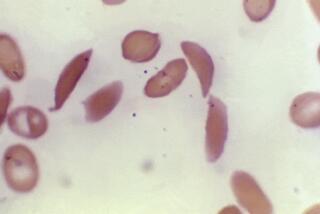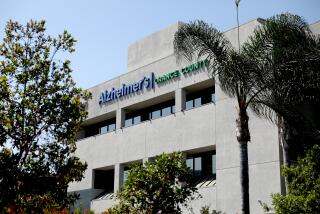‘Miracle’ Drug Attacks Rare Form of Cancer : Research: Tests at Scripps Research Institute show that a single seven-day treatment killed all detectable cancer cells in 11 of 12 leukemia patients.
- Share via
A drug developed at Scripps Research Institute has shown near-total effectiveness against a rare form of leukemia without the debilitating side effects that usually accompany cancer therapy, San Diego researchers say.
Reporting in today’s issue of the New England Journal of Medicine, the Scripps scientists were careful to point out that the cancer they studied, hairy-cell leukemia, is diagnosed in only 500 to 600 people a year in the United States.
Nonetheless, they believe that the dramatic effectiveness of 2-CdA and its development outside of a drug company makes it a harbinger of the use for “designer drugs” in cancer therapy.
A single seven-day treatment with 2-CdA killed all detectable cancer cells in 11 of 12 hairy-cell leukemia patients studied over the last four years, the scientists reported.
The 12th subject had a partial remission and refused further treatment. Similar results since have been seen in another dozen patients at Scripps and several in Houston, the researchers said.
The only two drugs commonly used against hairy-cell leukemia are alpha interferon and pentostatin. Both have less effectiveness, require longer treatments and cause toxic and debilitating side effects, doctors say.
This new drug “is an example of one of the very few chemotherapy agents which was rationally conceived and synthesized,” said Dr. Lawrence D. Piro, director of the study. “Essentially, it is a method of fooling the body by mimicking an inborn disease in humans.”
The drug, the full name of which is 2-chlorodeoxyadenosine, was developed at Scripps by Dr. Dennis A. Carson in the late 1970s. He targeted it because it showed potential for causing the same lymphocyte destruction that occurs in children who lack the enzyme adenosine deaminase.
Since that early deductive work by Carson, chemists at Scripps and elsewhere have turned to supercomputers to design drugs that eventually could be even more specific against cancer and other diseases.
The average patient in the Scripps study received a total 2-CdA dose of about 500 milligrams--a quantity smaller than the amount of aspirin it takes to banish a headache.
Side effects from 2-CdA were limited to a fever lasting an average of five days. No one experienced nausea, hair loss or other traditional chemotherapy side effects.
Although the treatment destroyed all the body’s white blood cells, the patients’ immune systems were back to normal within eight weeks, the researchers reported.
The drug also appears to result in partial remission in about half of patients with certain lymphomas and chronic lymphocytic leukemia. It is also in very early tests at Scripps on melanoma patients.
Hairy-cell leukemia is a cancer in which abnormal lymphocytes, or white blood cells, begin growing uncontrollably. Eventually they take over the bone marrow, destroying its ability to make clotting and infection-fighting cells.
Although the disease is seen as eventually fatal, it often grows so slowly that patients can live up to 25 years. It strikes four times as many men as women, usually in middle age.
So far, 2-CdA is available only at Scripps, UC San Francisco, the M.D. Anderson Institute in Houston and the Karolinska Institute in Sweden, Piro said.
Further dissemination of the drug is being held up by the reluctance of other research groups to assume financial liability for their tests, said Dr. Ernest Beutler, chairman of experimental medicine at Scripps.
Traditionally, drug companies develop new medicines and assume liability. In this case, however, Scripps was the developer and is declining to assume liability for tests it does not conduct. (Johnson & Johnson eventually is expected to market 2-CdA under an existing agreement that gives the firm first access to drugs pioneered at Scripps.)
It is the limited availability of and knowledge about 2-CdA that patients lamented at a Scripps press conference on Wednesday.
Thomas McClaren, a 48-year-old businessman from La Habra in Orange County, said it was only because his doctor had heard about the experiment at Scripps that he had access to 2-CdA.
“It’s unfortunate that one of the key missing ingredients in such a miracle drug is getting the word out,” McClaren said.
McClaren’s cancer has been in remission for two years. His tall frame carries 220 pounds, compared to 160 when he began treatment, and he can again play tennis.
Robert Koehler of Tucson said he too got to Scripps only by chance--his specialist in Tucson had been to a medical conference at which a Scripps researcher mentioned the 2-CdA results.
If publicity about the New England Journal of Medicine article brings hairy-cell leukemia patients to Scripps’ door, it will expand the possibilities for further studies of the drug, Piro said. One necessary test is a controlled trial of 2-CdA against the other existing drugs.
Beutler estimated that Scripps’ cancer center can accommodate an additional 30-40 patients per month in its testing program.
Because 2-CdA is experimental, patients are not charged for costs specifically associated with its administration. Routine blood testing and other monitoring tests in leukemia are usually billed to insurance, Piro said.
The clinic is beginning to give patients the drug on an outpatient basis, through a portable infusion pump. Patients must remain in the San Diego area at least two weeks.
Co-authors in the study in the New England Journal of Medicine today are Piro, Dr. Carlos J. Carrera, Carson and Beutler.






